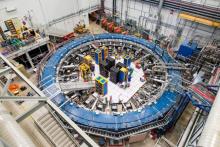Submitted by Shane D DeBolt
on
The first results from the Muon g-2 experiment at the U.S. Department of Energy’s Fermi National Accelerator Laboratory have revealed that fundamental particles called muons behave in a way that is not predicted by scientists’ best theory to date, the Standard Model of particle physics. This landmark result, published April 7 in Physical Review Letters, confirms a discrepancy that has been gnawing at researchers for decades.
The strong evidence that muons deviate from the Standard Model calculation might hint at exciting new physics. The muons in this experiment act as a window into the subatomic world and could be interacting with yet-undiscovered particles or forces.
Read more at UW News & New York Times
